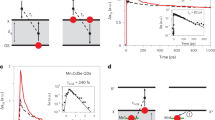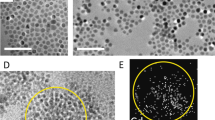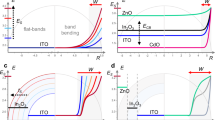Abstract
Magnetic doping of semiconductor nanostructures is actively pursued for applications in magnetic memory and spin-based electronics1,2. Central to these efforts is a drive to control the interaction strength between carriers (electrons and holes) and the embedded magnetic atoms3,4,5. In this respect, colloidal nanocrystal heterostructures provide great flexibility through growth-controlled ‘engineering’ of electron and hole wavefunctions in individual nanocrystals6,7. Here, we demonstrate a widely tunable magnetic sp–d exchange interaction between electron–hole excitations (excitons) and paramagnetic manganese ions using ‘inverted’ core–shell nanocrystals composed of Mn2+-doped ZnSe cores overcoated with undoped shells of narrower-gap CdSe. Magnetic circular dichroism studies reveal giant Zeeman spin splittings of the band-edge exciton that, surprisingly, are tunable in both magnitude and sign. Effective exciton g-factors are controllably tuned from −200 to +30 solely by increasing the CdSe shell thickness, demonstrating that strong quantum confinement and wavefunction engineering in heterostructured nanocrystal materials can be used to manipulate carrier–Mn2+ wavefunction overlap and the sp–d exchange parameters themselves.
This is a preview of subscription content, access via your institution
Access options
Subscribe to this journal
Receive 12 print issues and online access
$259.00 per year
only $21.58 per issue
Buy this article
- Purchase on Springer Link
- Instant access to full article PDF
Prices may be subject to local taxes which are calculated during checkout




Similar content being viewed by others
References
Ohno, H. et al. Electric-field control of ferromagnetism. Nature 408, 944–946 (2000).
Zutic, I., Fabian, J. & Das Sarma, S. Spintronics: Fundamentals and applications. Rev. Mod. Phys. 76, 323–410 (2004).
Furdyna, J. K. Diluted magnetic semiconductors. J. Appl. Phys. 64, R29–R64 (1988).
Awschalom, D. D. & Samarth, N. Spin dynamics and quantum transport in magnetic semiconductor quantum structures. J. Magn. Magn. Mater. 200, 130–147 (1999).
Kossut, J. Low-dimensional structures of diluted magnetic (semimagnetic) semiconductors—a subjective review. Acta Phys. Pol. A 100, 111–138 (2001).
Kim, S., Fisher, B., Eisler, H. J. & Bawendi, M. Type-II quantum dots: CdTe/CdSe(core/shell) and CdSe/ZnTe(core/shell) heterostructures. J. Am. Chem. Soc. 125, 11466–11467 (2003).
Balet, L. P. et al. Inverted core/shell nanocrystals continuously tunable between type-I and type-II localization regimes. Nano Lett. 4, 1485–1488 (2004).
Bacher, G. et al. Optical spectroscopy on individual CdSe/ZnMnSe quantum dots. Appl. Phys. Lett. 79, 524–527 (2001).
Kratzert, P. R., Puls, J., Rabe, M. & Henneberger, F. Growth and magneto-optical properties of sub 10 nm (Cd, Mn)Se quantum dots. Appl. Phys. Lett. 79, 2814–2816 (2001).
Besombes, L. et al. Probing the spin state of a single magnetic ion in an individual quantum dot. Phys. Rev. Lett. 93, 207403 (2004).
Bhargava, R. N., Gallagher, D., Hong, X. & Nurmikko, A. Optical properties of manganese-doped nanocrystals of ZnS. Phys. Rev. Lett. 72, 416–419 (1994).
Hoffman, D. M. et al. Giant internal magnetic fields in Mn doped nanocrystal quantum dots. Solid State Commun. 114, 547–550 (2000).
Radovanovic, P. V. & Gamelin, D. R. Electronic absorption spectroscopy of cobalt ions in diluted magnetic semiconductor quantum dots: Demonstration of an isocrystalline core/shell synthetic method. J. Am. Chem. Soc. 123, 12207–12214 (2001).
Norris, D. J., Yao, N., Charnock, F. T. & Kennedy, T. A. High-quality manganese-doped ZnSe nanocrystals. Nano Lett. 1, 3–7 (2001).
Archer, P. I., Santangelo, S. A. & Gamelin, D. R. Direct observation of sp–d exchange interactions in colloidal Mn2+- and Co2+-doped CdSe quantum dots. Nano Lett. 7, 1037–1043 (2007).
Norris, D. J., Efros, Al. L. & Erwin, S. C. Doped nanocrystals. Science 319, 1776–1779 (2008).
Bhattacharjee, A. K. & Perez-Conde, J. Optical properties of paramagnetic ion-doped semiconductor nanocrystals. Phys. Rev. B 68, 045303 (2003).
Archer, P. I., Santangelo, S. A. & Gamelin, D. R. Inorganic cluster syntheses of TM2+-doped quantum dots (CdSe, CdS, CdSe/CdS): Physical property dependence on dopant locale. J. Am. Chem. Soc. 129, 9808–9818 (2007).
Erwin, S. C. et al. Doping semiconductor nanocrystals. Nature 436, 91–94 (2005).
Beaulac, R. et al. Spin-polarizable excitonic luminescence in colloidal Mn2+-doped CdSe quantum dots. Nano Lett. 8, 1197–1201 (2008).
Kuno, M. et al. Magnetic circular dichroism study of CdSe quantum dots. J. Chem. Phys. 108, 4242–4247 (1998).
Myers, R. C. et al. Optoelectronic control of spin dynamics at near-terahertz frequencies in magnetically doped quantum wells. Phys. Rev. B 72, 041302 (2005).
Gaj, J. A. in Diluted Magnetic Semiconductors Vol. 25 (eds Furdyna, J. K. & Kossut, J.) 275–309 (Academic, 1988).
Efros, Al. L. et al. Band-edge exciton in quantum dots of semiconductors with a degenerate valence band: Dark and bright exciton states. Phys. Rev. B 54, 4843–4856 (1996).
Mackh, G., Ossau, W., Waag, A. & Landwehr, G. Effect of the reduction of dimensionality on the exchange parameters in semimagnetic semiconductors. Phys. Rev. B 54, R5227–R5230 (1996).
Merkulov, I. A. et al. Kinetic exchange between the conduction band electrons and magnetic ions in quantum-confined structures. Phys. Rev. Lett. 83, 1431–1434 (1999).
Myers, R. C. et al. Antiferromagnetic s–d exchange coupling in GaMnAs. Phys. Rev. Lett. 95, 017204 (2005).
Bhattacharjee, A. K. Confinement-induced reduction of the effective exchange parameters in semimagnetic semiconductor nanostructures. Phys. Rev. B 58, 15660–15665 (1998).
Larson, B. E. & Ehrenreich, H. Anisotropic superexchange and spin-resonance linewidth in diluted magnetic semiconductors. Phys. Rev. B 39, 1747–1759 (1989).
Acknowledgements
We thank B. Prall for technical assistance. This work was supported by Los Alamos LDRD Funds and the Chemical Sciences, Biosciences, and Geosciences Division of the Office of Basic Energy Sciences, Office of Science, US Department of Energy (DOE). D.A.B. and V.I.K. are partially supported by the DOE Center for Integrated Nanotechnologies jointly operated by Los Alamos and Sandia National Laboratories. A.L.E. acknowledges financial support from ONR.
Author information
Authors and Affiliations
Corresponding authors
Supplementary information
Rights and permissions
About this article
Cite this article
Bussian, D., Crooker, S., Yin, M. et al. Tunable magnetic exchange interactions in manganese-doped inverted core–shell ZnSe–CdSe nanocrystals. Nature Mater 8, 35–40 (2009). https://doi.org/10.1038/nmat2342
Received:
Accepted:
Published:
Issue Date:
DOI: https://doi.org/10.1038/nmat2342
This article is cited by
-
Breaking through the Mermin-Wagner limit in 2D van der Waals magnets
Nature Communications (2022)
-
Temperature-dependent anomalous Mn2+ emission and excited state dynamics in Mn2+-doped MAPbCl3-xBrx nanocrystals
Journal of Chemical Sciences (2021)
-
Excitonic pathway to photoinduced magnetism in colloidal nanocrystals with nonmagnetic dopants
Nature Nanotechnology (2018)
-
Remarkable impact of Ni2+ ion on the structural, optical, and magnetic properties of hexagonal wurtzite ZnS nanopowders
Applied Physics A (2018)
-
Doping concentration-dependent photoluminescence properties of Mn-doped Zn–In–S quantum dots
Journal of Materials Science (2018)



